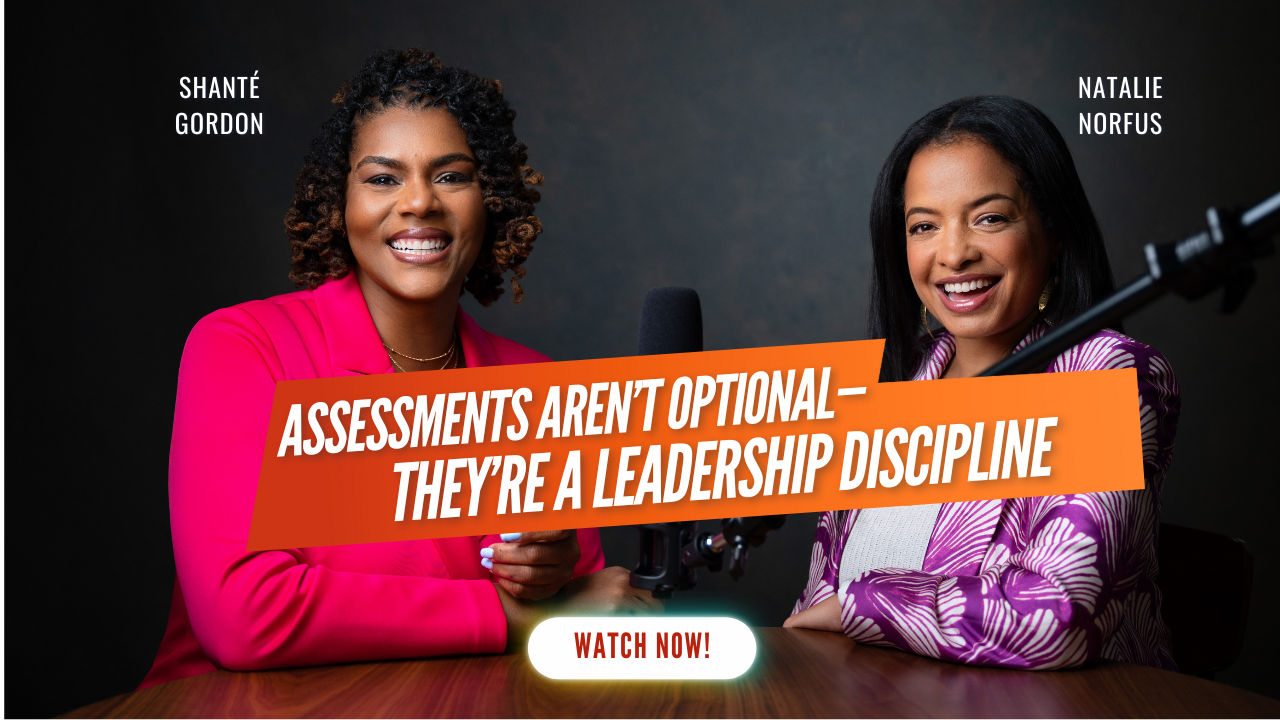Assessments Aren’t Optional—They’re a Leadership Discipline

If you’ve ever led a team or run a company, you know one inevitable truth about people: they change, and so does your workplace culture. Yet many organizations still treat culture assessments as a one-and-done checkbox instead of what they truly are: a critical mirror to what’s happening under the surface.
In this episode of What’s the DEIL?, we (Natalie and Shanté) get honest about why workplace culture assessments are more than HR fluff; they’re leadership essentials.
Why We’re Still Talking About Assessments
Let’s be honest: the phrase “workplace culture assessment” doesn’t exactly scream excitement. But the results? Done right, they’re sexy, not in the behind-closed-doors kind of way, but in the “we just reduced turnover by 20%” kind of way.
We’ve seen firsthand that the organizations that do assessments well, who actually listen, act, and learn, build resilient, inclusive, and high-performing teams.
So, why now? Because the world has changed. Your last pulse survey may have been during the pre-pandemic, pre-election cycle, pre-Great Resignation, and pre-XYZ industry shakeup. In today’s climate, if you’re not regularly taking the pulse of your people, you’re leading blind.
What an Assessment Really Is (And What It’s Not)
Some consider assessments like SATs an effort to get a single score. But at The Norfus Firm, we take a different view.
A real workplace assessment is a process. It’s:
- Data Collection – Gathering honest, nuanced input from your people.
- Analysis – Interpreting that data in the context of your org’s values and goals.
- Insight + Action – Using those insights to make meaningful decisions.
If all you’re getting is a number, without the story behind it, you’re missing the point.
The Score Obsession: A Leadership Trap
We’ve all been conditioned since grade school to value scores. Straight A’s. Performance reviews. “Top 100 Best Places to Work” badges.
But here’s the deal: you’re only as good as your people think you are. That shiny award your HR lead filled out a form for? Meaningless if your employees are disengaged, your culture’s toxic, or you’re unaware of deeper issues simmering under the surface.
It’s not about looking better than Company X. It’s about being better than you were six months ago.
Why Once a Year Isn’t Enough
Many companies follow a neat annual cadence, surveying in the spring and maybe again in the fall. But think about how much can change in a few months. Elections. Layoffs. Leadership shifts. Cultural flashpoints. A single survey once a year won’t cut it.
Your people data should reflect your business reality in real time. And if you’ve taken action on feedback from the last assessment, great! But if not, don’t keep asking. Nothing erodes trust faster than ignoring employee input.
“But We Didn’t Know It Was That Bad…”
That phrase we hear most from leaders when they finally read the assessment report—or worse, when it’s still sealed in an envelope (true story). The truth is, cultural data often surprises leaders because people challenges don’t show up on spreadsheets.
You don’t need to be an expert in people data, but you do need to be open to the mirror. The good, the bad, the hard-to-hear. That openness? It’s the beginning of actual leadership.
Leadership Isn’t About Knowing Everything
One reason leaders avoid assessments? Ego. Many still believe their job is to have all the answers. But here’s a radical idea: great leaders don’t know everything. They ask.
And asking the right questions—like “Do you feel heard?”, “What’s one thing we could do better?”—can build trust faster than any town hall speech. Especially in smaller teams, just holding 15-minute chats and showing curiosity goes a long way.
Everyone Doesn’t Need the Same Thing
Here’s what most forget: people are not spreadsheets. They don’t respond the same way. We interviewed four employees with completely different reactions and comfort levels in one investigation. We would’ve missed key details if we had taken a one-size-fits-all approach.
The same goes for your team. You can’t lead everyone the same way, but you can ask smart questions and adjust your approach accordingly.
Assessments Without Action? Just Paperwork.
Let’s say you do the survey. You collect responses. You even get a nice slide deck of results. But then… crickets. No follow-up. No changes. No communication.
That’s not assessment. That’s wasting people’s time.
Data without dialogue is disrespectful. And if you’re not ready to act on it, don’t ask for it. Instead, figure out a realistic cadence, get the right people involved (HR, DEI, data analysts), and set clear timelines for action.
A Simple Framework for Starting (or Restarting) Assessments
Keep it simple if you’re overwhelmed by the thought of culture assessments. Here’s how to get started:
- Know Your Why: What are you trying to understand? Apathy? Burnout? Inclusion gaps?
- Ask Better Questions: Focus on belonging, psychological safety, and clarity.
- Use the Right Tools: This isn’t the time for DIY SurveyMonkey specials. Lean on your people experts.
- Analyze Thoughtfully: Bring in people who can read and interpret culture data.
- Communicate Clearly: Share what you’ve learned and plan to do.
- Act + Reassess: Culture is fluid. Keep checking the mirror. Keep adjusting.
Final Thoughts: Culture is a Living Thing
There is no finish line in culture work. No destination. It’s messy, human, evolving work—and it matters.
Culture assessments aren’t optional. They’re the mirror your leadership needs. Because how you make people feel in the day-to-day determines how long they stay, how well they perform, and how far your business can go.
So do yourself (and your team) a favor: pick up the mirror, look closely, and commit to growing from what you see.
Connect With Us
If you found this discussion compelling, we invite you to connect with us further. Here are some ways to stay in touch:
- Follow Natalie Norfus on LinkedIn
- Follow Shanté Gordon on LinkedIn
- Book a consultation with The Norfus Firm
- Follow What’s the DEIL on Instagram and TikTok
